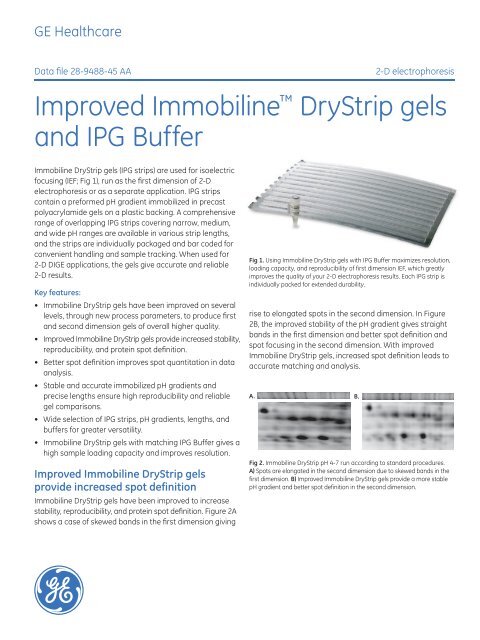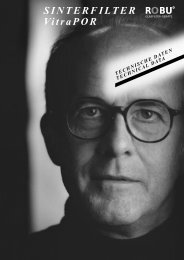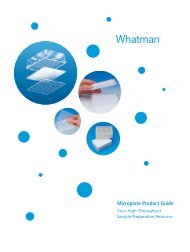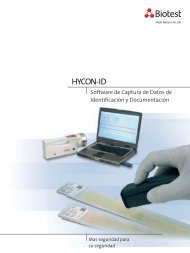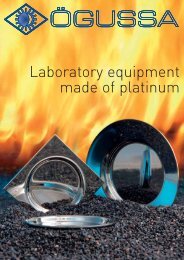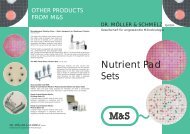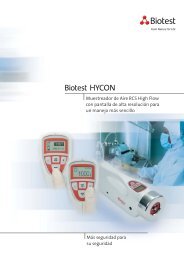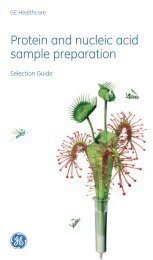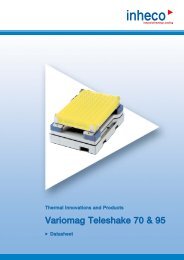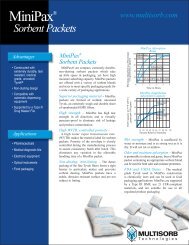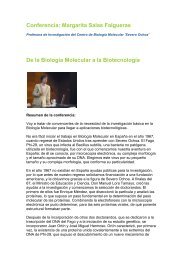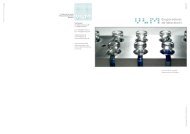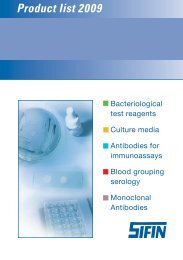Improved Immobiline⢠DryStrip gels and IPG Buffer - Acefesa.es
Improved Immobiline⢠DryStrip gels and IPG Buffer - Acefesa.es
Improved Immobiline⢠DryStrip gels and IPG Buffer - Acefesa.es
Create successful ePaper yourself
Turn your PDF publications into a flip-book with our unique Google optimized e-Paper software.
GE Healthcare<br />
Data file 28-9488-45 AA<br />
2-D electrophor<strong>es</strong>is<br />
<strong>Improved</strong> Immobiline <strong>DryStrip</strong> <strong>gels</strong><br />
<strong>and</strong> <strong>IPG</strong> <strong>Buffer</strong><br />
Immobiline <strong>DryStrip</strong> <strong>gels</strong> (<strong>IPG</strong> strips) are used for isoelectric<br />
focusing (IEF; Fig 1), run as the first dimension of 2-D<br />
electrophor<strong>es</strong>is or as a separate application. <strong>IPG</strong> strips<br />
contain a preformed pH gradient immobilized in precast<br />
polyacrylamide <strong>gels</strong> on a plastic backing. A comprehensive<br />
range of overlapping <strong>IPG</strong> strips covering narrow, medium,<br />
<strong>and</strong> wide pH rang<strong>es</strong> are available in various strip lengths,<br />
<strong>and</strong> the strips are individually packaged <strong>and</strong> bar coded for<br />
convenient h<strong>and</strong>ling <strong>and</strong> sample tracking. When used for<br />
2-D DIGE applications, the <strong>gels</strong> give accurate <strong>and</strong> reliable<br />
2-D r<strong>es</strong>ults.<br />
Key featur<strong>es</strong>:<br />
• Immobiline <strong>DryStrip</strong> <strong>gels</strong> have been improved on several<br />
levels, through new proc<strong>es</strong>s parameters, to produce first<br />
<strong>and</strong> second dimension <strong>gels</strong> of overall higher quality.<br />
• <strong>Improved</strong> Immobiline <strong>DryStrip</strong> <strong>gels</strong> provide increased stability,<br />
reproducibility, <strong>and</strong> protein spot definition.<br />
• Better spot definition improv<strong>es</strong> spot quantitation in data<br />
analysis.<br />
• Stable <strong>and</strong> accurate immobilized pH gradients <strong>and</strong><br />
precise lengths ensure high reproducibility <strong>and</strong> reliable<br />
gel comparisons.<br />
• Wide selection of <strong>IPG</strong> strips, pH gradients, lengths, <strong>and</strong><br />
buffers for greater versatility.<br />
• Immobiline <strong>DryStrip</strong> <strong>gels</strong> with matching <strong>IPG</strong> <strong>Buffer</strong> giv<strong>es</strong> a<br />
high sample loading capacity <strong>and</strong> improv<strong>es</strong> r<strong>es</strong>olution.<br />
<strong>Improved</strong> Immobiline <strong>DryStrip</strong> <strong>gels</strong><br />
provide increased spot definition<br />
Immobiline <strong>DryStrip</strong> <strong>gels</strong> have been improved to increase<br />
stability, reproducibility, <strong>and</strong> protein spot definition. Figure 2A<br />
shows a case of skewed b<strong>and</strong>s in the first dimension giving<br />
Fig 1. Using Immobiline <strong>DryStrip</strong> <strong>gels</strong> with <strong>IPG</strong> <strong>Buffer</strong> maximiz<strong>es</strong> r<strong>es</strong>olution,<br />
loading capacity, <strong>and</strong> reproducibility of first dimension IEF, which greatly<br />
improv<strong>es</strong> the quality of your 2-D electrophor<strong>es</strong>is r<strong>es</strong>ults. Each <strong>IPG</strong> strip is<br />
individually packed for extended durability.<br />
rise to elongated spots in the second dimension. In Figure<br />
2B, the improved stability of the pH gradient giv<strong>es</strong> straight<br />
b<strong>and</strong>s in the first dimension <strong>and</strong> better spot definition <strong>and</strong><br />
spot focusing in the second dimension. With improved<br />
Immobiline <strong>DryStrip</strong> <strong>gels</strong>, increased spot definition leads to<br />
accurate matching <strong>and</strong> analysis.<br />
A. B.<br />
Fig 2. Immobiline <strong>DryStrip</strong> pH 4-7 run according to st<strong>and</strong>ard procedur<strong>es</strong>.<br />
A) Spots are elongated in the second dimension due to skewed b<strong>and</strong>s in the<br />
first dimension. B) <strong>Improved</strong> Immobiline <strong>DryStrip</strong> <strong>gels</strong> provide a more stable<br />
pH gradient <strong>and</strong> better spot definition in the second dimension.<br />
imagination at work
Basic pH area<br />
of Immobiline<br />
<strong>DryStrip</strong> pH<br />
3-11 NL<br />
A. Immobiline <strong>DryStrip</strong> pH 3-11 NL B. Immobiline <strong>DryStrip</strong> Strip pH 3-5.6<br />
C. Immobiline <strong>DryStrip</strong> pH 5.3-6.5 D. Immobiline <strong>DryStrip</strong> pH 6.2-7.5 E. Immobiline <strong>DryStrip</strong> pH 7-11 NL<br />
Fig 3. 2-D gel imag<strong>es</strong> using A) wide range Immobiline <strong>DryStrip</strong> pH 3-11NL or B-E) four overlapping narrow range <strong>IPG</strong> strips. Immobiline <strong>DryStrip</strong> pH 7-11 NL<br />
is able to r<strong>es</strong>olve a number of spots that were lost in the basic area of Immobiline <strong>DryStrip</strong> pH 3-11 NL.<br />
Higher r<strong>es</strong>olution using narrow range<br />
Immobiline <strong>DryStrip</strong> <strong>gels</strong><br />
To maximize r<strong>es</strong>olution, four overlapping narrow range <strong>IPG</strong><br />
strips were used <strong>and</strong> the spot maps were analyzed using<br />
ImageMaster 2D Platinum. The analysis was compared to<br />
data obtained using the wide range Immobiline <strong>DryStrip</strong> pH<br />
3-11 NL, <strong>and</strong> the analys<strong>es</strong> revealed a 200% increase of detected<br />
protein spots. Figure 3 shows the gel imag<strong>es</strong> from the narrow<br />
<strong>and</strong> wide range <strong>IPG</strong> strips. Figure 3E shows that Immobiline<br />
<strong>DryStrip</strong> pH 7-11 NL was able to r<strong>es</strong>olve several spots that<br />
were lost in the basic area of Immobiline <strong>DryStrip</strong> pH 3-11 NL.<br />
<strong>Improved</strong> <strong>IPG</strong> <strong>Buffer</strong> pH 3-10 <strong>and</strong><br />
pH 3-10 NL increas<strong>es</strong> r<strong>es</strong>olution<br />
<strong>IPG</strong> <strong>Buffer</strong> pH 3-10 <strong>and</strong> pH 3-10 NL have been improved with<br />
a new formula. The improved buffer formula was compared<br />
with the old formula based on the r<strong>es</strong>ulting 2-D spot maps.<br />
The quality of the <strong>gels</strong> was evaluated both by a panel of<br />
six experienced 2-D users <strong>and</strong> by software analysis using<br />
ImageMaster 2D Platinum. The panel evaluated several triplicate<br />
sets of 2-D spot maps using either improved <strong>IPG</strong> <strong>Buffer</strong> or<br />
previous <strong>IPG</strong> <strong>Buffer</strong> formulations, <strong>and</strong> based their evaluation<br />
on the numbers of spots, intensity, <strong>and</strong> focusing of the spots.<br />
Using ImageMaster 2D Platinum, the 2-D maps were evaluated<br />
based on spot intensity, spot matching, <strong>and</strong> spot numbers. The<br />
basic pH area of two 2-D spot maps is shown in Figure 4, while<br />
Figure 5 shows the complete 2-D spot maps. Both inv<strong>es</strong>tigation<br />
methods demonstrated that the improved buffers gave<br />
additional spots in the high molecular weight area <strong>and</strong> basic<br />
pH area of the gel, as well as spots with increased intensiti<strong>es</strong>.<br />
By increasing the intensity of low intensity spots, the probability<br />
of detecting low abundant proteins is increased. Note that<br />
the improved formula for <strong>IPG</strong> <strong>Buffer</strong> pH 3-10 <strong>and</strong> pH 3-10 NL<br />
giv<strong>es</strong> rise to a higher background in the basic pH area of the<br />
gel when using silver or Coomassie staining. This higher<br />
background can be avoided by prolonging the fixation time to<br />
3 hours or up to overnight if needed.<br />
Sample labeling: Lysed E.coli cells (50 µg) labeled with CyDye DIGE Fluor,<br />
Cy5 minimal dye<br />
Sample buffer: 8 M urea, 4% CHAPS, 40 mM DTT, <strong>and</strong> 2% <strong>IPG</strong> <strong>Buffer</strong><br />
pH 3-10 NL.<br />
First dimension IEF: Immobiline <strong>DryStrip</strong> <strong>gels</strong> (pH 3-10 NL; 18 cm) were<br />
rehydrated overnight at room temperature with<br />
D<strong>es</strong>treak Rehydration Solution <strong>and</strong> 0.5% <strong>IPG</strong> <strong>Buffer</strong> pH<br />
3-10 NL. The sample was applied by anodic cup loading<br />
<strong>and</strong> focused for 24 kVh.<br />
Second dimension: Run on Ettan DALTtwelve electrophor<strong>es</strong>is system<br />
using 12.5% labcast Laemmli <strong>gels</strong>.<br />
A. B.<br />
Fig 4. The basic area of 2-D protein spot maps using Immobiline <strong>DryStrip</strong> pH<br />
3-10 NL (18 cm) together with A) improved <strong>IPG</strong> <strong>Buffer</strong> pH 3-10 NL or B) the<br />
previous recipe for <strong>IPG</strong> <strong>Buffer</strong> pH 3-10 NL. The improved <strong>IPG</strong> <strong>Buffer</strong> formula<br />
r<strong>es</strong>ults in additional spots, <strong>and</strong> some of the differenc<strong>es</strong> are indicated in the figure.<br />
2 28-9488-45 AA
A. B.<br />
Fig. 5. 2-D protein spot maps using Immobiline <strong>DryStrip</strong> pH 3-10 NL (18 cm)<br />
together with A) improved <strong>IPG</strong> <strong>Buffer</strong> pH 3-10 NL or B) the previous <strong>IPG</strong> <strong>Buffer</strong><br />
pH 3-10 NL formulation. Experimental conditions were identical to the<br />
conditions in Figure 4.<br />
Choosing <strong>IPG</strong> strip <strong>and</strong> buffer<br />
A comprehensive range of overlapping <strong>IPG</strong> strips covering<br />
narrow (~1 pH unit), medium (3-5 pH units), <strong>and</strong> wide (~8 pH<br />
units) pH rang<strong>es</strong> are available in five different strip lengths<br />
(7, 11, 13, 18, <strong>and</strong> 24 cm). To simplify gel use <strong>and</strong> record<br />
keeping, each strip is labeled with the pH interval, batch<br />
number, individual number, <strong>and</strong> bar code for use with<br />
a reader. Figure 6 shows an overview of the <strong>IPG</strong> strips<br />
available along with the matching <strong>IPG</strong> <strong>Buffer</strong>s. The combination<br />
of <strong>IPG</strong> strip <strong>and</strong> <strong>IPG</strong> <strong>Buffer</strong> of matching pH interval improv<strong>es</strong><br />
the conductivity distribution across the pH gradient during<br />
IEF. The technical specifications for Immobiline <strong>DryStrip</strong> <strong>gels</strong><br />
<strong>and</strong> <strong>IPG</strong> <strong>Buffer</strong>s are shown in Table 1.<br />
To gain a broad overview of total protein distribution,<br />
select wide range <strong>IPG</strong> strips such as Immobiline <strong>DryStrip</strong><br />
pH 3–11 NL. Choose shorter strips, up to 13 cm, for fast,<br />
cost-effective screening, for a quick overview, or when<br />
only the most abundant proteins are of inter<strong>es</strong>t (as in<br />
prefractionated protein sampl<strong>es</strong>). The short<strong>es</strong>t <strong>IPG</strong> strips<br />
give the fast<strong>es</strong>t r<strong>es</strong>ults, but their sample load is limited. For<br />
more detailed studi<strong>es</strong>, choose medium range <strong>IPG</strong> strips.<br />
To obtain higher r<strong>es</strong>olution, narrow range <strong>IPG</strong> strips may<br />
be used. Use the longer 18 <strong>and</strong> 24 cm strips for maximal<br />
r<strong>es</strong>olution <strong>and</strong> loading capacity. Longer strips allow<br />
detection of more spots <strong>and</strong> make it easier to select <strong>and</strong><br />
identify the proteins in the spots, but require longer focusing<br />
tim<strong>es</strong>. For a more detailed insight into protein distribution,<br />
combine medium range Immobiline <strong>DryStrip</strong> pH 3–7 (or<br />
pH 4–7) <strong>and</strong> pH 6–11 (alternatively, pH 6–9 or pH 7-11). This<br />
combination is also useful for preparative applications.<br />
Medium range <strong>IPG</strong> strips in the 24 cm long format deliver<br />
both high r<strong>es</strong>olution <strong>and</strong> high protein loading capacity, both<br />
of which improve protein identification <strong>and</strong> characterization<br />
later in the workflow. Deep Purple, Coomassie, or silver<br />
stained spots can be picked from the gel <strong>and</strong> identified by<br />
mass spectrometry.<br />
Table 1. Technical specifications for Immobiline <strong>DryStrip</strong> <strong>gels</strong> <strong>and</strong> <strong>IPG</strong> <strong>Buffer</strong><br />
Immobiline <strong>DryStrip</strong><br />
Gel dimensions 70 × 3 × 0.5 mm, 110 × 3 × 0.5 mm,<br />
130 × 3 × 0.5 mm, 180 × 3 × 0.5 mm,<br />
240 × 3 × 0.5 mm<br />
Gel matrix Polyacrylamide T = 4%, C = 3%<br />
Gel backing Poly<strong>es</strong>ter film<br />
Storage<br />
-20°C<br />
Shelf life<br />
18 months<br />
<strong>IPG</strong> <strong>Buffer</strong><br />
Content<br />
Volume<br />
Storage 4ºC to 8ºC<br />
Shelf life<br />
36 months<br />
Specialized carrier ampholyt<strong>es</strong> in<br />
aqueous solution<br />
1 ml<br />
<strong>IPG</strong> Strips<br />
Strip length<br />
<strong>IPG</strong> <strong>Buffer</strong>s<br />
pH range<br />
24 cm 18 cm 13 cm 11 cm 7 cm 3.5-5.0 5.5-6.7 4-7 6-11 7-11 NL 3-10 NL 3-10 3-11 NL<br />
Narrow<br />
3.5-4.5 × <br />
5.3-6.5 × × × × × <br />
6.2-7.5 × × × × × <br />
Medium<br />
3-5.6 NL × × × × × <br />
3-7 NL × <br />
4-7 × × × × × <br />
6-9 × × <br />
6-11 × × × × <br />
7-11 NL × × × × × <br />
Wide<br />
3-10 × × × × × <br />
3-11 NL × × × × × <br />
3-10 NL × × × × <br />
Fig 6. A comprehensive range of overlapping <strong>IPG</strong> strips covering narrow, medium, <strong>and</strong> wide pH rang<strong>es</strong> are available in several different strip lengths.<br />
Using <strong>IPG</strong> strips together with matching <strong>IPG</strong> <strong>Buffer</strong> improv<strong>es</strong> the conductivity distribution across the pH gradient during IEF.<br />
28-9488-45 AA 3
<strong>IPG</strong>box<br />
Immobiline <strong>DryStrip</strong> gel packs are shipped dry for stability.<br />
<strong>IPG</strong>box provid<strong>es</strong> a convenient method for rehydrating up to<br />
twelve precast <strong>IPG</strong> strips (7 to 24 cm) at a time. Individual slots<br />
in the R<strong>es</strong>well Trays allow rehydration of individual <strong>IPG</strong> strips<br />
in a minimum volume of solution, <strong>and</strong> no oil is required.<br />
<strong>IPG</strong>box can accommodate all <strong>IPG</strong> strip siz<strong>es</strong> including 7, 11,<br />
13, 18, <strong>and</strong> 24 cm (Fig 7). <strong>IPG</strong>box is supplied with a complete<br />
set of acc<strong>es</strong>sori<strong>es</strong> to rehydrate 10 full rounds of 12 strips<br />
each. To avoid redox-related streaking, <strong>IPG</strong> strips should be<br />
rehydrated with DeStreak Rehydration Solution.<br />
Fig 7. <strong>IPG</strong>box is specially d<strong>es</strong>igned for rehydrating Immobiline <strong>DryStrip</strong> <strong>gels</strong><br />
in a minimum volume of solution.<br />
Synchronized solutions for better 2-D electrophor<strong>es</strong>is - improved 2-D DIGE<br />
2-D electrophor<strong>es</strong>is is a powerful technology for comparing<br />
complex protein mixtur<strong>es</strong> from biological sampl<strong>es</strong> in<br />
proteomics r<strong>es</strong>earch. With the aim of simplifying the proc<strong>es</strong>s<br />
<strong>and</strong> improving quantitation, GE Healthcare has made<br />
significant improvements across the entire workflow, from<br />
sample prep <strong>and</strong> separation to data analysis. 2-D DIGE<br />
(Difference Gel Electrophor<strong>es</strong>is) allows you to analyze<br />
differenc<strong>es</strong> in low abundance proteins with unparalleled<br />
statistical confidence. Many of our 2-D electrophor<strong>es</strong>is<br />
products improve data quality from traditional 2-D experiments<br />
as well, <strong>and</strong> the products can eventually be integrated into<br />
a complete solution to maximally improve your 2-D r<strong>es</strong>ults.<br />
<br />
Sample Preparation Protein Labeling Protein Separation Image Acquisition Image Analysis Validation<br />
2-D Protein<br />
Extraction <strong>Buffer</strong><br />
DIGE Trial Pack<br />
CyDye DIGE Fluor<br />
2 nmol kit<br />
CyDye DIGE 400 nmol<br />
sat dye<br />
CyDye DIGE repackaging<br />
<strong>IPG</strong>box<br />
Ettan DIGE Imager<br />
Immobiline <strong>DryStrip</strong> <strong>gels</strong> Typhoon Variable<br />
<strong>IPG</strong> <strong>Buffer</strong><br />
Mode Imager<br />
DIGE Gel <strong>and</strong><br />
DIGE <strong>Buffer</strong> Kit<br />
DeCyder 2-D software v7.0 ECL Plex<br />
ImageQuant TL 7.0 with<br />
ImageQuant TL SecurITy<br />
For more information, visit www.gelif<strong>es</strong>cienc<strong>es</strong>.com/2DE<br />
4 28-9488-45 AA
Ordering information<br />
Product Quantity Code No<br />
<strong>IPG</strong> <strong>Buffer</strong> pH 3.5-5.0 1 ml 17-6002-02<br />
<strong>IPG</strong> <strong>Buffer</strong> pH 5.5-6.7 1 ml 17-6002-06<br />
<strong>IPG</strong> <strong>Buffer</strong> pH 4-7 1 ml 17-6000-86<br />
<strong>IPG</strong> <strong>Buffer</strong> pH 6-11 1 ml 17-6001-78<br />
<strong>IPG</strong> <strong>Buffer</strong> pH 7-11 NL 1 ml 17-6004-39<br />
<strong>IPG</strong> <strong>Buffer</strong> pH 3-10 1 ml 17-6000-87<br />
<strong>IPG</strong> <strong>Buffer</strong> pH 3-10 NL 1 ml 17-6000-88<br />
<strong>IPG</strong> <strong>Buffer</strong> pH 3-11 NL 1 ml 17-6004-40<br />
Related literature<br />
Code No<br />
2-D Electrophor<strong>es</strong>is: Principl<strong>es</strong> <strong>and</strong><br />
80-6429-60<br />
Methods, H<strong>and</strong>book<br />
Ettan DIGE System User Manual 18-1173-17<br />
Related products Quantity Code No<br />
<strong>IPG</strong>box 1 <strong>IPG</strong>box + 28-9334-65<br />
1 <strong>IPG</strong>box Kit<br />
<strong>IPG</strong>box Kit<br />
10 R<strong>es</strong>well 28-9334-92<br />
Trays +<br />
1 <strong>IPG</strong>box<br />
Insert<br />
DeStreak Rehydration Solution 5 × 3 ml 17-6003-19<br />
DeStreak Reagent 1 ml 17-6003-18<br />
Ettan <strong>IPG</strong>phor 3 Isoelectric<br />
1 11-0033-64<br />
Focusing Unit<br />
Ettan <strong>IPG</strong>phor Manifold, Complete 1 80-6498-38<br />
Ettan <strong>IPG</strong>phor Manifold,<br />
Light Complete<br />
1 11-0026-88<br />
Immobiline <strong>DryStrip</strong> <strong>gels</strong> 1<br />
Code No<br />
Narrow range pH 3.5-4.5 pH 5.3-6.5 pH 6.2-7.5<br />
24 cm 17-6002-38 17-6003-62 17-6003-67<br />
18 cm - 17-6003-61 17-6003-66<br />
13 cm - 17-6003-60 17-6003-65<br />
11 cm - 17-6003-59 17-6003-64<br />
7 cm - 17-6003-58 17-6003-63<br />
Medium range pH 3-5.6 NL pH 3-7 NL pH 4-7 pH 6-9 pH 6-11 pH 7-11 NL<br />
24 cm 17-6003-57 17-6002-43 17-6002-46 17-6002-47 - 17-6003-72<br />
18 cm 17-6003-56 - 17-1233-01 17-6001-88 17-6001-97 17-6003-71<br />
13 cm 17-6003-55 - 17-6001-13 - 17-6001-96 17-6003-70<br />
11 cm 17-6003-54 - 18-1016-60 - 17-6001-95 17-6003-69<br />
7 cm 17-6003-53 - 17-6001-10 - 17-6001-94 17-6003-68<br />
Wide range pH 3-10 pH 3-10 NL pH 3-11 NL<br />
24 cm 17-6002-44 17-6002-45 17-6003-77<br />
18 cm 17-1234-01 17-1235-01 17-6003-76<br />
13 cm 17-6001-14 17-6001-15 17-6003-75<br />
11 cm 18-1016-61 - 17-6003-74<br />
7 cm 17-6001-11 17-6001-12 17-6003-73<br />
1<br />
Pack size is 12 strips/pack<br />
28-9488-45 AA 5
For local office contact information, visit<br />
www.gelif<strong>es</strong>cienc<strong>es</strong>.com/contact<br />
www.gelif<strong>es</strong>cienc<strong>es</strong>.com/2DE<br />
GE Healthcare Bio-Scienc<strong>es</strong> AB<br />
Björkgatan 30<br />
751 84 Uppsala<br />
Sweden<br />
imagination at work<br />
GE, imagination at work, <strong>and</strong> GE monogram are trademarks of General Electric Company.<br />
Cy, CyDye, DeCyder, Deep Purple, ECL Plex, Ettan, ImageMaster, ImageQuant, Immobiline, <strong>IPG</strong>phor, <strong>and</strong><br />
Typhoon are trademarks of GE Healthcare compani<strong>es</strong>.<br />
2-D Fluor<strong>es</strong>cence Difference Gel Electrophor<strong>es</strong>is (2-D DIGE) technology is covered by US patent numbers<br />
6,043,025, 6,127,134 <strong>and</strong> 6,426,190 <strong>and</strong> equivalent patents <strong>and</strong> patent applications in other countri<strong>es</strong><br />
<strong>and</strong> exclusively licensed from Carnegie Mellon University. CyDye: this product or portions thereof is<br />
manufactured under an exclusive license from Carnegie Mellon University under US patent numbers<br />
5,569,587, 5,627,027 <strong>and</strong> equivalent patents in other countri<strong>es</strong>. The purchase of CyDye DIGE Fluors includ<strong>es</strong><br />
a limited license to use the CyDye DIGE Fluors for internal r<strong>es</strong>earch <strong>and</strong> development, but not for any<br />
commercial purpos<strong>es</strong>. A license to use the CyDye DIGE Fluors for commercial purpos<strong>es</strong> is subject to a<br />
separate license agreement with GE Healthcare.<br />
CyDye: This product or portions thereof is manufactured under an exclusive license from Carnegie Mellon<br />
University under US patent number 5,268,486 <strong>and</strong> equivalent patents in the US <strong>and</strong> other countri<strong>es</strong>.<br />
The purchase of CyDye products includ<strong>es</strong> a limited license to use the CyDye products for internal<br />
r<strong>es</strong>earch <strong>and</strong> development but not for any commercial purpos<strong>es</strong>. A license to use the CyDye products for<br />
commercial purpos<strong>es</strong> is subject to a separate license agreement with GE Healthcare. Commercial use<br />
shall include:<br />
1. Sale, lease, license or other transfer of the material or any material derived or produced from it.<br />
2. Sale, lease, license or other grant of rights to use this material or any material derived or produced from it.<br />
3. Use of this material to perform servic<strong>es</strong> for a fee for third parti<strong>es</strong>, including contract r<strong>es</strong>earch <strong>and</strong> drug<br />
screening.<br />
If you require a commercial license to use this material <strong>and</strong> do not have one, return this material<br />
unopened to GE Healthcare Bio-Scienc<strong>es</strong> AB, Bjorkgatan 30, SE-751 84 Uppsala, Sweden <strong>and</strong> any money<br />
paid for the material will be refunded.<br />
DeCyder: This release of DeCyder (software) is provided by GE Healthcare to the customer under<br />
a nonexclusive license <strong>and</strong> is subject to terms <strong>and</strong> conditions set out in the 2-D Differential Gel<br />
Electrophor<strong>es</strong>is Technology Acc<strong>es</strong>s Agreement. Customer has no rights to copy or duplicate or amend the<br />
Software without the prior written approval of GE Healthcare.<br />
Deep Purple Total Protein Stain is exclusively licensed to GE Healthcare from Fluorotechnics Pty Ltd.Deep<br />
Purple Total Protein Stain may only be used for applications in life science r<strong>es</strong>earch.Deep Purple is covered<br />
under a granted patent in New Zeal<strong>and</strong> entitled “Fluor<strong>es</strong>cent Compounds”, patent number 522291 <strong>and</strong><br />
equivalent patents <strong>and</strong> patent applications in other countri<strong>es</strong>.<br />
DIGE Gel <strong>and</strong> DIGE <strong>Buffer</strong> Kit: The buffer system in this gel <strong>and</strong> buffer kit is covered by patent application<br />
WO9616724 granted in US, EP <strong>and</strong> JP.<br />
This version of ImageMaster has been developed by the Swiss Institute of Bioinformatics in collaboration<br />
with GeneBio <strong>and</strong> GE Healthcare.<br />
All third party trademarks are the property of their r<strong>es</strong>pective owners.<br />
© 2009 General Electric Company—All rights r<strong>es</strong>erved.<br />
First published Mar. 2009<br />
All goods <strong>and</strong> servic<strong>es</strong> are sold subject to the terms <strong>and</strong> conditions of sale of the company within GE<br />
Healthcare which suppli<strong>es</strong> them. A copy of th<strong>es</strong>e terms <strong>and</strong> conditions is available on requ<strong>es</strong>t. Contact<br />
your local GE Healthcare repr<strong>es</strong>entative for the most current information.<br />
GE Healthcare UK Limited Amersham Place<br />
Little Chalfont<br />
Buckinghamshire, HP7 9NA<br />
UK<br />
GE Healthcare Europe, GmbH<br />
Munzinger Strasse 5<br />
D-79111 Freiburg<br />
Germany<br />
GE Healthcare Bio-Scienc<strong>es</strong> Corp.<br />
800 Centennial Avenue, P.O. Box 1327<br />
Piscataway, NJ 08855-1327<br />
USA<br />
GE Healthcare Bio-Scienc<strong>es</strong> KK<br />
Sanken Bldg., 3-25-1, Hyakunincho<br />
Shinjuku-ku, Tokyo 169-0073<br />
Japan<br />
28-9488-45 AA 03/2009


